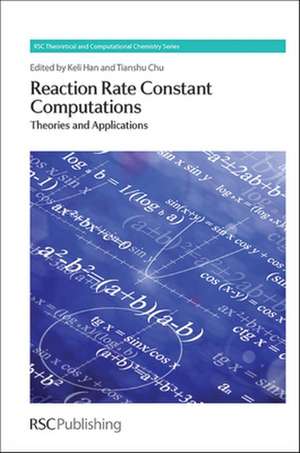Reaction Rate Constant Computations: Theoretical and Computational Chemistry Series
en Limba Engleză Hardback – 17 oct 2013
Din seria Theoretical and Computational Chemistry Series
- 14%
 Preț: 1384.45 lei
Preț: 1384.45 lei - 20%
 Preț: 1127.74 lei
Preț: 1127.74 lei - 14%
 Preț: 1378.23 lei
Preț: 1378.23 lei - 14%
 Preț: 1211.87 lei
Preț: 1211.87 lei - 14%
 Preț: 1541.81 lei
Preț: 1541.81 lei - 20%
 Preț: 1385.33 lei
Preț: 1385.33 lei - 9%
 Preț: 1241.07 lei
Preț: 1241.07 lei - 9%
 Preț: 1171.83 lei
Preț: 1171.83 lei - 9%
 Preț: 1030.98 lei
Preț: 1030.98 lei - 9%
 Preț: 1170.75 lei
Preț: 1170.75 lei - 9%
 Preț: 1170.75 lei
Preț: 1170.75 lei - 9%
 Preț: 1240.92 lei
Preț: 1240.92 lei - 9%
 Preț: 1240.41 lei
Preț: 1240.41 lei - 9%
 Preț: 1240.41 lei
Preț: 1240.41 lei - 9%
 Preț: 1239.76 lei
Preț: 1239.76 lei
Preț: 1111.89 lei
Preț vechi: 1221.85 lei
-9% Nou
212.83€ • 231.26$ • 178.89£
Cartea se retipărește
Specificații
ISBN-10: 1849736502
Pagini: 572
Ilustrații: illustrations
Dimensiuni: 163 x 237 x 38 mm
Greutate: 1.03 kg
Editura: Royal Society Of Chemistry
Seria Theoretical and Computational Chemistry Series
Notă biografică
Cuprins
Textul de pe ultima copertă
The reaction rate constant plays an essential role a wide range of processes in biology, chemistry and physics. Calculating the reaction rate constant provides considerable understanding to a reaction and this book presents the latest thinking in modern rate computational theory.
The editors have more than 30 years experience in researching the theoretical computation of chemical reaction rate constants by global dynamics and transition state theories and have brought together a global pool of expertise discussing these in a variety of contexts and across all phases. This thorough treatment of the subject provides an essential handbook to students and researchers entering the field and a comprehensive reference to established practitioners across the sciences, providing better tools to determining reaction rate constants.
"